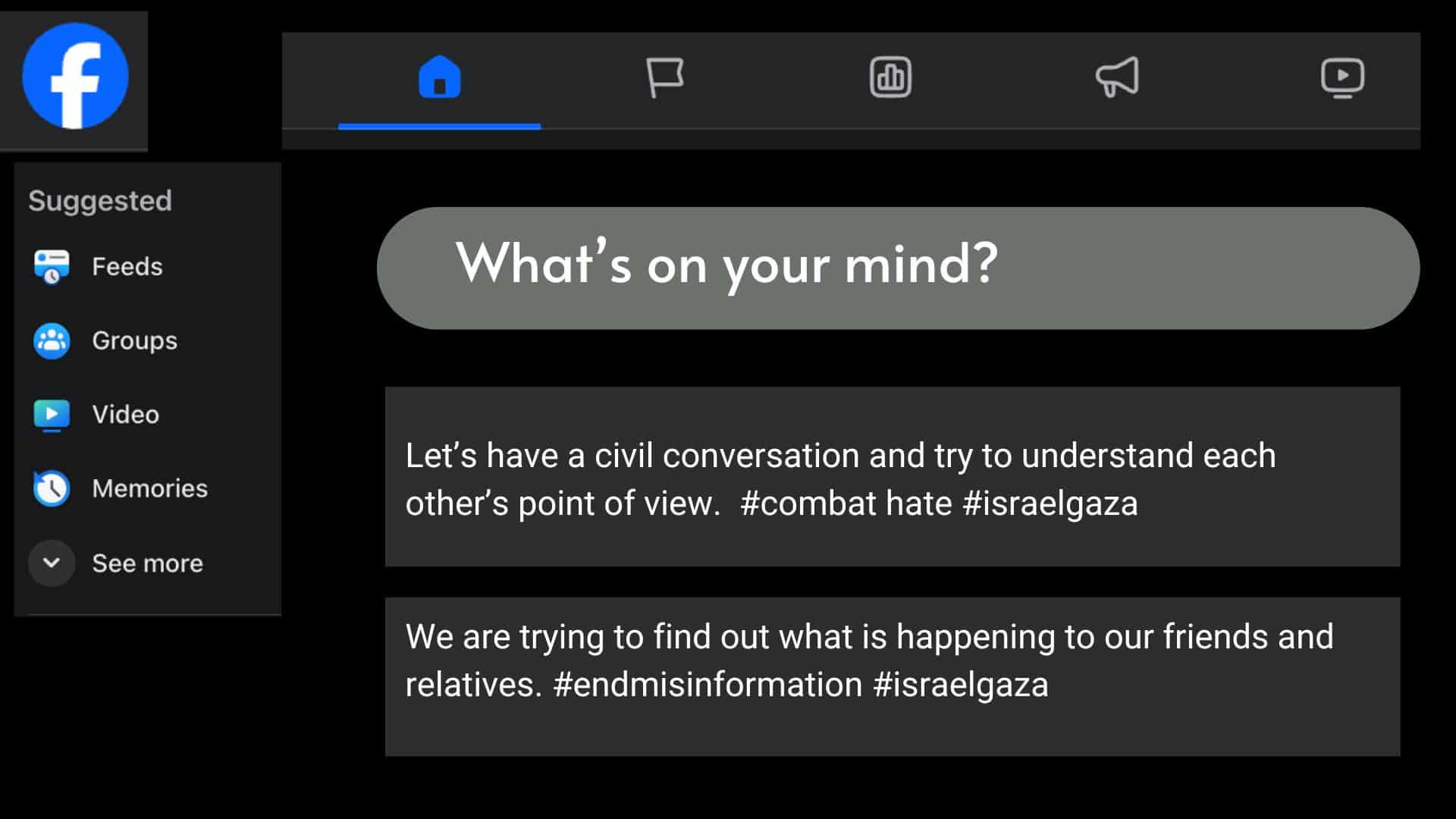From Gaza to Israel to the United States some people are turning to social media for civil discussion. Can we stop disinformation about the Middle East?

Posts on an imaginary social media page calling for civil dialogue about the Middle East. (Illustration by News Decoder)
This article, by undergraduate student Ella Gorodetzky, was produced as part of News Decoder’s educational mission to foster global awareness through journalism. Gorodetzky is a student at the University of Wisconsin-Madison in the United States. Learn more about how News Decoder can work with your school.
Posts about the ongoing Israel-Hamas war have flooded social media platforms since Hamas, the militant group which governs the Gaza Strip, launched a surprise attack on Israel on 7 October 2023. While some creators use their platforms to educate, others spread polarizing claims and misinformation.
Netta Asner-Minster, a Jewish educator living in Jerusalem, has been using her Instagram platform of more than 20,000 followers to share donation resources and personal stories from Israelis.
“It’s like an outlet and a way for me to express what’s going on and feel like I’m contributing,” Asner-Minster said.
Many creators have been sharing similar stories in the hopes of raising awareness for the innocent people caught in the middle of the conflict.
Mais is a yoga instructor living in Dubai whose family was displaced from Palestine in the 1948 Arab-Israeli War. She asked that her last name remain anonymous due to past hate messages. She uses her Instagram platform of more than 24,000 followers to educate on the Palestinian crisis and share informational resources. She still has many family and friends living in the West Bank, Israel and Gaza.
Pouring hopes, fears and hatreds onto social media
Instagram, TikTok, X, Facebook and more have seen millions of posts about the war since its start. The Economic Times reported that X saw over 50 million posts about the conflict in one weekend. In response, they have “removed newly-created accounts affiliated with Hamas” and updated their policy on what is considered newsworthy, according to the Al Jazeera news service.
Fighting between Hamas and the Israeli government has been ongoing since the initial attack by Hamas, which saw hundreds of people kidnapped and killed in Israel, and Israeli reprisals which have taken the lives of more than 22,000 Palestinians. Innocent civilians on both sides have been injured and displaced from homes.
This war is only the most recent escalation in the decades-old Israeli-Palestinian conflict. The 1948 Arab-Israeli War, which ensued after the British ended its occupation of the area, resulted in the establishment of the state of Israel and, consequently, the displacement of thousands of Palestinians.
Tensions in the area have been present since, especially once Israel gained control of the West Bank and Gaza Strip territories in 1967 as a result of the Six-Day War.
Palestinians have protested against Israel’s military occupation of the two territories and treatment of the Palestinians living there ever since, according to the Council on Foreign Relations. Violence increased in 2007 when the terrorist group Hamas took control of the Gaza Strip after Israel’s disengagement from the territory, according to Reuters.
A social media response to real-life violence and terror
Social media platforms have become a source for mass information and misinformation about the war.
According to Columbia University Professor Rashid Khalidi in his book “The Hundred Years’ War on Palestine,” Palestinians first gained a voice in Western media with the emergence of the Palestinian Liberation Organization as an independent Palestinian actor in 1967.
Now social media is playing a part in amplifying those stories.
“It’s very common that you don’t have Palestinians that are born and raised in Palestine, but carry the cause and the mission and the name within their hearts,” Mais said.
Neither of Mais or Asner-Minster’s regular content is centered around Israeli-Palestinian politics, but both are choosing to post about the topic in light of the current violence.
“I decided I didn’t want to share the horror videos, and I didn’t want to share too much politics,” Asner-Minster said. “I just use my platform to give voice to everyday people who are living in Israel and how it’s affecting us.”
Sharing gritty realities with the wider world
Asner-Minster posted a video on 7 October assuring her followers of her family’s safety and sharing her personal recount of hearing the Red Alert sirens — alarms indicating rocket fire — in Jerusalem and running with her one-year-old daughter to the bomb shelter.
Mais also shares personal thoughts and posts about the conflict. “I do a lot of reposting and re-sharing of the sources that I trust and see and verify and do my research behind,” Mais said. “I also create my own videos and content around the misinformation that happens specifically in the West or in Europe.”
Mais believes that Western media headlines are misleading. They lack background on the history of oppression of the Palestinian people, she said.
“It’s censored, it’s minimal, it’s misguided, it’s misleading,” Mais said. “And that’s why I find it super important, whether it’s to follow content creators in Israel or in Palestine on the floor, to be more of a trusted source than the news outlets and media.”
However, social media is also notorious for spreading misinformation and polarization, according to a study by the University of Southern California (USC).
Social media can inflame hostilities.
A common social media trope is broad, one-sided, generalized statements. One Instagram poster wrote: “If you are pro-Palestine that means you agree that Jews don’t have the right to live in Israel.”
Another posted: “To stand with Israel is to stand with genocide.” Posts like these falsely equate being pro-Israel or pro-Palestine with a certain negative trait and are common on social media.
In reality, being “pro-” either could have any number of meanings; a person can stand with the Israeli people and state while simultaneously condemning the actions of their government; a person can stand with the Palestinian people while also condemning the actions of Hamas.
A viral TikTok video with more than 4.4 million views makes a blanket statement: “The Western media is extremely white supremacist, and that is how racism works. Israelis get to be white, Palestinians are non-white.”
By the confident tone, the creator is easy to believe. However, the creator is not an expert on the conflict. The video was stitched by a non-white Israeli disproving the claim. But millions of users have seen the original video and the misinformation has been spread.
Over-simplified statements like those seen in Instagram infographics are insensitive to the nuance of the conflict, as well as the innocent people actually affected, according to the USC study. They erase the history and emotion that come with the decades-old struggle.
Feelings can’t be reduced to short posts.
Both Asner-Minster and Mais described a constant feeling of anxiety for their family and friends that cannot be captured in a three-sentence-long social media infographic.
“There’s constantly this feeling that any moment there could be a siren and we’ll have to jump up and go to the bomb shelter,” Asner-Minster said. “Also just the feeling of not knowing what’s going to happen at any moment.”
Mais described a similar worry for her loved ones in Gaza.
“I’m very disoriented and I feel sometimes I’m not functioning right, even at work or with my family,” Mais said. “I have so many friends here in Dubai who have been in the same distressed and mentally fatigued and disoriented state of mind because it’s a humanitarian cause, it’s never easy to see this.”
In addition, labeling people as “pro-” any side — or “anti-” if they don’t agree with the creator — has an extremely polarizing effect, which is easily spread through social media, according to an analysis from 13 October 2023 by Business Insider reporters Kelsey Vlamis and Erin Snodgrass.
Hope that good can drown out the bad
But although social media has its downsides, both Asner-Minster and Mais are hopeful their platforms are spreading good.
Asner-Minster and Mais, along with many other creators, post longer explanation videos in addition to infographic-type posts. They both feel it is important to share real information and educate.
“Me and my family are trying to hold up,” Mais said. “We’re trying to stay strong because I know that we need to be the voice of those who aren’t heard. And we need to keep posting about it. We need to keep shedding light on the current situation.”
Asner-Minster finds it helpful to post personal stories from everyday people. “Maybe things that don’t meet the eye, or wouldn’t necessarily be covered in news because it’s not newsy enough,” she explained.
Mais hopes that educating and sharing the truth will help lead to more understanding and empathy.
“Just keep spreading the truth as much as possible in the hopes to one day find that beautiful coexistence,” Mais said.
Three questions to consider:
- How do the people quoted in the story seek to fight misinformation online?
- Is social media a good means of fostering meaningful dialogue?
- How might you go about combatting hateful social media?

Ella Gorodetzky is an undergraduate student at the University of Wisconsin-Madison majoring in journalism and political science. She is the news manager at The Daily Cardinal and is passionate about writing on politics and the environment.
Read more News Decoder stories about social media:
